Molecularly Imprinted Magnetic Nanocomposite Based on Carboxymethyl Dextrin for Removal of Ciprofloxacin Antibiotic from Contaminated Water
Abstract
:1. Introduction
2. Experimental
2.1. Materials and Instruments
2.2. Preparation of Carboxymethyl Dextrin (CMD)
2.3. Preparation of Iron Oxide Nanoparticles
2.4. Preparation of Copper Oxide Nanoparticles
2.5. Preparation of Fe3O4/CuO Hybrid Nanoparticles
2.6. Fabrication of MMIP
2.7. Antibacterial Study
2.8. Adsorption Experiments
2.9. Desorption and Reusability
3. Results and Discussion
3.1. Characterization
3.2. Optimization of the Effective Parameters on the Ciprofloxacin Adsorption
3.2.1. Solution pH
3.2.2. Adsorbent Dosage
3.2.3. Contact Time
3.2.4. The Initial Concentration
3.3. Isotherm Study
3.4. Adsorption Kinetics
3.5. Recovery and Reusability
3.6. Ciprofloxacin Adsorption Mechanism
4. Conclusions
Author Contributions
Funding
Data Availability Statement
Conflicts of Interest
References
- Lotfollahzadeh, R.; Yari, M.; Sedaghat, S.; Delbari, A.S. Biosynthesis and characterization of silver nanoparti-cles for the removal of amoxicillin from aqueous solutions using Oenothera biennis water extract. J. Nanostruct. Chem. 2021, 11, 693–706. [Google Scholar] [CrossRef]
- Sarfjoo, M.R.; Shad, A.; Hassanpour, M.; Varma, R. An Overview on New Anticancer Drugs Approved by Food and Drug Administration: Impending Economic and Environmental Challenges. Mater. Chem. Horizons 2022, 1, 189–198. [Google Scholar] [CrossRef]
- Eike, D.; Marcus, R.; Dirk, J. The Database “Pharmaceuticals in the Environment”-Update and New Analysis Final Report; German Environment Agency: Dessau-Roßlau, Germany, 2019; p. 67. [Google Scholar]
- Mosavi, S.S.; Zare, E.N.; Behniafar, H.; Tajbakhsh, M. Removal of Amoxicillin Antibiotic from Polluted Wa-ter by a Magnetic Bionanocomposite Based on Carboxymethyl Tragacanth Gum-Grafted-Polyaniline. Water 2023, 15, 202. [Google Scholar] [CrossRef]
- Baquero, F.; Martínez, J.-L.; Cantón, R. Antibiotics and antibiotic resistance in water environments. Curr. Opin. Biotechnol. 2008, 19, 260–265. [Google Scholar] [CrossRef]
- Gulen, B.; Demircivi, P. Adsorption properties of flouroquinolone type antibiotic ciprofloxacin into 2:1 dioc-tahedral clay structure: Box-Behnken experimental design. J. Mol. Struct. 2020, 1206, 127659. [Google Scholar] [CrossRef]
- Tran, Q.T.; Huong Do, T.; Ha, X.L.; Nguyen, H.P.; Nguyen, A.T.; Quyen Ngo, T.C.; Chau, H.D. Study of the Ciprofloxacin Adsorption of Activated Carbon Prepared from Mangosteen Peel. Appl. Sci. 2022, 12, 8770. [Google Scholar] [CrossRef]
- Tiwari, B.; Sellamuthu, B.; Ouarda, Y.; Drogui, P.; Tyagi, R.D.; Buelna, G. Review on fate and mechanism of removal of pharmaceutical pollutants from wastewater using biological approach. Bioresour. Technol. 2017, 224, 1–12. [Google Scholar] [CrossRef] [Green Version]
- Schulz, J.; Kemper, N.; Hartung, J.; Janusch, F.; Mohring, S.A.I.; Hamscher, G. Analysis of fluoroquinolones in dusts from intensive livestock farming and the co-occurrence of fluoroquinolone-resistant Escherichia coli. Sci. Rep. 2019, 9, 5117. [Google Scholar] [CrossRef] [Green Version]
- Gavrilescu, M.; Demnerová, K.; Aamand, J.; Agathos, S.; Fava, F. Emerging pollutants in the environment: Present and future challenges in biomonitoring, ecological risks and bioremediation. N. Biotechnol. 2015, 32, 147–156. [Google Scholar] [CrossRef]
- Li, S.; Cai, M.; Liu, Y.; Wang, C.; Lv, K.; Chen, X. S-Scheme photocatalyst TaON/Bi2WO6 nanofibers with ox-ygen vacancies for efficient abatement of antibiotics and Cr (VI): Intermediate eco-toxicity analysis and mechanistic insights. Chinese J. Catal. 2022, 43, 2652–2664. [Google Scholar] [CrossRef]
- Nurrokhimah, M.; Nurerk, P.; Kanatharana, P.; Bunkoed, O. A nanosorbent consisting of a magnetic molecularly imprinted polymer and graphene oxide for multi-residue analysis of cephalosporins. Microchim. Acta 2019, 186, 822. [Google Scholar] [CrossRef] [PubMed]
- Cai, M.; Liu, Y.; Wang, C.; Lin, W.; Li, S. Novel Cd0. 5Zn0. 5S/Bi2MoO6 S-scheme heterojunction for boosting the photodegradation of antibiotic enrofloxacin: Degradation pathway, mechanism and toxicity assessment. Sep. Purif. Technol. 2023, 304, 122401. [Google Scholar] [CrossRef]
- Gorito, A.M.; Ribeiro, A.R.L.; Rodrigues, P.; Pereira, M.F.R.; Guimarães, L.; Almeida, C.M.R.; Silva, A.M.T. Antibiotics removal from aquaculture effluents by ozonation: Chemical and toxicity descriptors. Water Res. 2022, 218, 118497. [Google Scholar] [CrossRef] [PubMed]
- Arslan-Alaton, I.; Dogruel, S. Pre-treatment of penicillin formulation effluent by advanced oxidation processes. J. Hazard. Mater. 2004, 112, 105–113. [Google Scholar] [CrossRef]
- Li, X.; Liu, T.; Zhang, Y.; Cai, J.; He, M.; Li, M.; Chen, Z.; Zhang, L. Growth of BiOBr/ZIF-67 Nanocomposites on Carbon Fiber Cloth as Filter-Membrane-Shaped Photocatalyst for Degrading Pollutants in Flowing Wastewater. Adv. Fiber Mater. 2022, 304, 1620–1631. [Google Scholar] [CrossRef]
- Ghanbari, R.; Amanat, N. Approaches of Membrane Modification for Water Treatment. Mater. Chem. Horizons 2022, 1, 153–167. [Google Scholar] [CrossRef]
- Igwegbe, C.A.; Oba, S.N.; Aniagor, C.O.; Adeniyi, A.G.; Ighalo, J.O. Adsorption of ciprofloxacin from water: A comprehensive review. J. Ind. Eng. Chem. 2021, 93, 57–77. [Google Scholar] [CrossRef]
- Mehdizadeh, A.; Najafi Moghadam, P.; Ehsanimehr, S.; Fareghi, A.R. Preparation of a New Magnetic Nano-composite for the Removal of Dye Pollutions from Aqueous Solutions: Synthesis and Characterization. Mater. Chem. Horizons 2022, 1, 23–34. [Google Scholar] [CrossRef]
- Hassanzadeh-Afruzi, F.; Heidari, G.; Maleki, A. Magnetic Nanocomposite Hydrogel based on Arabic Gum for Remediation of Lead(II) from Contaminated Water. Mater. Chem. Horizons 2022, 1, 107–122. [Google Scholar] [CrossRef]
- Akter, T.; Bañuelos, J.L.; Andrade, D.; Bañuelos, D.I.; Saupe, G.B. Rapid Adsorption Mechanism of Meth-ylene Blue onto a Porous Mixed Ti-Nb Oxide. Mater. Chem. Horizons 2022, 1, 49–67. [Google Scholar] [CrossRef]
- Zare, E.N.; Fallah, Z.; Le, V.T.; Doan, V.-D.; Mudhoo, A.; Joo, S.-W.; Vasseghian, Y.; Tajbakhsh, M.; Moradi, O.; Sillanpää, M. Remediation of pharmaceuticals from contaminated water by molecularly imprinted polymers: A review. Environ. Chem. Lett. 2022, 1–36. [Google Scholar] [CrossRef] [PubMed]
- Liu, Y.; Lian, Z.; Li, F.; Majid, A.; Wang, J. Review on molecular imprinting technology and its application in pre-treatment and detection of marine organic pollutants. Mar. Pollut. Bull. 2021, 169, 112541. [Google Scholar] [CrossRef]
- Li, N.; Yang, H. Construction of natural polymeric imprinted materials and their applications in water treatment: A review. J. Hazard. Mater. 2021, 403, 123643. [Google Scholar] [CrossRef] [PubMed]
- Pan, J.; Chen, W.; Ma, Y.; Pan, G. Molecularly imprinted polymers as receptor mimics for selective cell recognition. Chem. Soc. Rev. 2018, 47, 5574–5587. [Google Scholar] [CrossRef]
- Sajini, T.; Mathew, B. A brief overview of molecularly imprinted polymers: Highlighting computational de-sign, nano and photo-responsive imprinting. Talanta Open 2021, 4, 100072. [Google Scholar] [CrossRef]
- Pichon, V.; Chapuis-Hugon, F. Role of molecularly imprinted polymers for selective determination of envi-ronmental pollutants-A review. Anal. Chim. Acta 2008, 622, 48–61. [Google Scholar] [CrossRef]
- Islamipour, Z.; Zare, E.N.; Salimi, F.; Ghomi, M.; Makvandi, P. Biodegradable antibacterial and antioxidant nanocomposite films based on dextrin for bioactive food packaging. J. Nanostruct. Chem. 2022, 12, 991–1006. [Google Scholar] [CrossRef]
- Vinu, D.; Govindaraju, K.; Vasantharaja, R.; Amreen Nisa, S.; Kannan, M.; Vijai Anand, K. Biogenic zinc oxide, copper oxide and selenium nanoparticles: Preparation, characterization and their anti-bacterial activity against Vibrio parahaemolyticus. J. Nanostruct. Chem. 2021, 11, 271–286. [Google Scholar] [CrossRef]
- Tran, C.D.; Makuvaza, J.; Munson, E.; Bennett, B. Biocompatible Copper Oxide Nanoparticle Composites from Cellulose and Chitosan: Facile Synthesis, Unique Structure, and Antimicrobial Activity. ACS Appl. Mater. Interfaces 2017, 9, 42503–42515. [Google Scholar] [CrossRef] [Green Version]
- Imai, K.; Ogawa, H.; Bui, V.N.; Inoue, H.; Fukuda, J.; Ohba, M.; Yamamoto, Y.; Nakamura, K. Inactivation of high and low pathogenic avian influenza virus H5 subtypes by copper ions incorporated in zeolite-textile materials. Antiviral Res. 2012, 93, 225–233. [Google Scholar] [CrossRef]
- Zhang, Q.; Zhang, K.; Xu, D.; Yang, G.; Huang, H.; Nie, F.; Liu, C.; Yang, S. CuO nanostructures: Synthesis, characterization, growth mechanisms, fundamental properties, and applications. Prog. Mater. Sci. 2014, 60, 208–337. [Google Scholar] [CrossRef]
- Safari, J.; Zarnegar, Z. Ultrasonic activated efficient synthesis of chromenes using amino-silane modified Fe3O4 nanoparticles: A versatile integration of high catalytic activity and facile recovery. J. Mol. Struct. 2014, 1072, 53–60. [Google Scholar] [CrossRef]
- Abdollahi, Z.; Zare, E.N.; Salimi, F.; Goudarzi, I.; Tay, F.R.; Makvandi, P. Bioactive carboxymethyl starch-based hydrogels decorated with cuo nanoparticles: Antioxidant and antimicrobial properties and ac-celerated wound healing in vivo. Int. J. Mol. Sci. 2021, 22, 2531. [Google Scholar] [CrossRef]
- Sun, J.; Zhao, R.; Zeng, J.; Li, G.; Li, X. Characterization of destrins with different Dextrose Equivalents. Molecules 2010, 15, 5162. [Google Scholar] [CrossRef] [Green Version]
- Kheyrabadi, F.B.; Zare, E.N. Antimicrobial nanocomposite adsorbent based on poly (me-ta-phenylenediamine) for remediation of lead (II) from water medium. Sci. Rep. 2022, 12, 4632. [Google Scholar]
- Selamat, M.E.; Sulaiman, O.; Hashim, R.; Hiziroglu, S.; Nadhari, W.N.A.W.; Sulaiman, N.S.; Razali, M.Z. Measurement of some particleboard properties bonded with modified carboxymethyl starch of oil palm trunk. Measurement 2014, 53, 251–259. [Google Scholar] [CrossRef]
- Pahlevanzadeh, F.; Setayeshmehr, M.; Bakhsheshi-Rad, H.R.; Emadi, R.; Kharaziha, M.; Poursamar, S.A.; Ismail, A.F.; Sharif, S.; Chen, X.; Berto, F. A Review on Antibacterial Biomaterials in Biomedical Applications: From Materials Perspective to Bioinks Design. Polymers 2022, 14, 2238. [Google Scholar] [CrossRef]
- Sikora, P.; Augustyniak, A.; Cendrowski, K.; Nawrotek, P.; Mijowska, E. Antimicrobial activity of Al2O3, CuO, Fe3O4, and ZnO nanoparticles in scope of their further application in cement-based building materials. Nanomaterials 2018, 8, 212. [Google Scholar] [CrossRef] [Green Version]
- Ghahremanloo, A.; Zare, E.N.; Salimi, F.; Makvandi, P. Electroconductive and photoactive poly(phenylenediamine)s with antioxidant and antimicrobial activities for potential photothermal therapy. New J. Chem. 2022, 46, 6255–6266. [Google Scholar] [CrossRef]
- Sahoo, J.K.; Paikra, S.K.; Baliarsingh, A.; Panda, D.; Rath, S.; Mishra, M.; Sahoo, H. Surface functionalization of graphene oxide using amino silane magnetic nanocomposite for Chromium (VI) removal and bacterial treatment. Nano Express 2020, 1, 010062. [Google Scholar] [CrossRef]
- Nazarzadeh Zare, E.; Mansour Lakouraj, M.; Mohseni, M. Biodegradable polypyrrole/dextrin conductive nanocomposite: Synthesis, characterization, antioxidant and antibacterial activity. Synth. Met. 2014, 187, 9–16. [Google Scholar] [CrossRef]
- Dhiman, N. Analysis of non competitive and competitive adsorption behaviour of ciprofloxacin hydrochlo-ride and ofloxacin hydrochloride from aqueous solution using oryza sativa husk ash (single and binary ad-sorption of antibiotics). Clean. Mater. 2022, 5, 100108. [Google Scholar] [CrossRef]
- Chandrasekaran, A.; Patra, C.; Narayanasamy, S.; Subbiah, S. Adsorptive removal of Ciprofloxacin and Amoxicillin from single and binary aqueous systems using acid-activated carbon from Prosopis juliflora. Environ. Res. 2020, 188, 109825. [Google Scholar] [CrossRef]
- Lin, C.C.; Lee, C.Y. Adsorption of ciprofloxacin in water using Fe3O4 nanoparticles formed at low tempera-ture and high reactant concentrations in a rotating packed bed with co-precipitatio. Mater. Chem. Phys. 2020, 240, 122049. [Google Scholar] [CrossRef]
- Hassanzadeh-Afruzi, F.; Maleki, A.; Zare, E.N. Efficient remediation of chlorpyrifos pesticide from contam-inated water by superparamagnetic adsorbent based on Arabic gum-grafted-polyamidoxime. Int. J. Biol. Macromol. 2022, 203, 445–456. [Google Scholar] [CrossRef]
- Verma, S.P.; Sarkar, B. Simultaneous removal of Cd (II) and p-cresol from wastewater by micellar-enhanced ultrafiltration using rhamnolipid: Flux decline, adsorption kinetics and isotherm studies. J. Environ. Manage. 2018, 213, 217–235. [Google Scholar] [CrossRef]
- Zheng, D.; Wu, M.; Zheng, E.; Wang, Y.; Feng, C.; Zou, J.; Juan, M.; Bai, X.; Wang, T.; Shi, Y. Parallel adsorption of low concentrated ciprofloxacin by a CoFe-LDH modified sludge biochar. J. Environ. Chem. Eng. 2022, 10, 108381. [Google Scholar] [CrossRef]
- Zare, E.N.; Lakouraj, M.M.; Kasirian, N. Development of effective nano-biosorbent based on poly m-phenylenediamine grafted dextrin for removal of Pb (II) and methylene blue from water. Carbohydr. Polym. 2018, 201, 539–548. [Google Scholar] [CrossRef]
- Zare, E.N.; Lakouraj, M.M.; Ramezani, A. Efficient sorption of Pb(II) from an aqueous solution using a poly(aniline-co-3-aminobenzoic acid)-based magnetic core-shell nanocomposite. New J. Chem. 2016, 40, 2521–2529. [Google Scholar] [CrossRef]
- Yuan, Y.; Yang, D.; Mei, G.; Hong, X.; Wu, J.; Zheng, J.; Pang, J.; Yan, Z. Preparation of konjac glucoman-nan-based zeolitic imidazolate framework-8 composite aerogels with high adsorptive capacity of ciproflox-acin from water. Colloids Surfaces A Physicochem. Eng. Asp. 2018, 544, 187–195. [Google Scholar] [CrossRef]
- Zheng, C.; Zheng, H.; Hu, C.; Wang, Y.; Wang, Y.; Zhao, C.; Ding, W.; Sun, Q. Structural design of magnetic biosorbents for the removal of ciprofloxacin from water. Bioresour. Technol. 2020, 296, 122288. [Google Scholar] [CrossRef]
- Amirmahani, N.; Mahdizadeh, H.; Malakootian, M.; Pardakhty, A.; Mahmoodi, N.O. Evaluating Nanoparti-cles Decorated on Fe3O4@SiO2-Schiff Base (Fe3O4@SiO2-APTMS-HBA) in Adsorption of Ciprofloxacin from Aqueous Environments. J. Inorg. Organomet. Polym. Mater. 2020, 30, 3540–3551. [Google Scholar] [CrossRef]
- Privar, Y.; Shashura, D.; Pestov, A.; Modin, E.; Baklykov, A.; Marinin, D.; Bratskaya, S. Metal-chelate sorbents based on carboxyalkylchitosans: Ciprofloxacin uptake by Cu(II) and Al(III)-chelated cryogels of N-(2-carboxyethyl)chitosan. Int. J. Biol. Macromol. 2019, 131, 806–811. [Google Scholar] [CrossRef]
- Zhuang, Y.; Yu, F.; Ma, J.; Chen, J. Enhanced adsorption removal of antibiotics from aqueous solutions by modified alginate/graphene double network porous hydrogel. J. Colloid Interface Sci. 2017, 507, 250–259. [Google Scholar] [CrossRef]
- Li, L.; Zhao, J.; Sun, Y.; Yu, F.; Ma, J. Ionically cross-linked sodium alginate/ĸ-carrageenan double-network gel beads with low-swelling, enhanced mechanical properties, and excellent adsorption performance. Chem. Eng. J. 2019, 372, 1091–1103. [Google Scholar] [CrossRef]
- Wang, F.; Yang, B.; Wang, H.; Song, Q.; Tan, F.; Cao, Y. Removal of ciprofloxacin from aqueous solution by a magnetic chitosan grafted graphene oxide composite. J. Mol. Liq. 2016, 222, 188–194. [Google Scholar] [CrossRef]
- Kulkarni, S.; Kaware, J. Regeneration and recovery in adsorption-a review. Int. J. Innov. Sci. Eng. Technol. 2014, 1, 61–64. [Google Scholar]
- Bizi, M.; El Bachra, F.E. Evaluation of the ciprofloxacin adsorption capacity of common industrial minerals and application to tap water treatment. Powder Technol. 2020, 362, 323–333. [Google Scholar] [CrossRef]
- Jain, A.; Sharma, A.; Kapur, A.; Wadhawan, S.; Garg, M.; Kumar Pandey, S.; Singh, S.; Kumar Mehta, S. Hematite dysprosium oxide nanocomposites biosynthesized via greener route for ciprofloxacin removal and antimicrobial activity. J. Nanostruct. Chem. 2021, 11, 437–453. [Google Scholar] [CrossRef]
- Soares, S.F.; Nogueira, J.; Trindade, T.; Daniel-da-Silva, A.L. Towards efficient ciprofloxacin adsorption using magnetic hybrid nanoparticles prepared with κ-, ι-, and λ-carrageenan. J. Nanostruct. Chem. 2022, 1–20. [Google Scholar] [CrossRef]
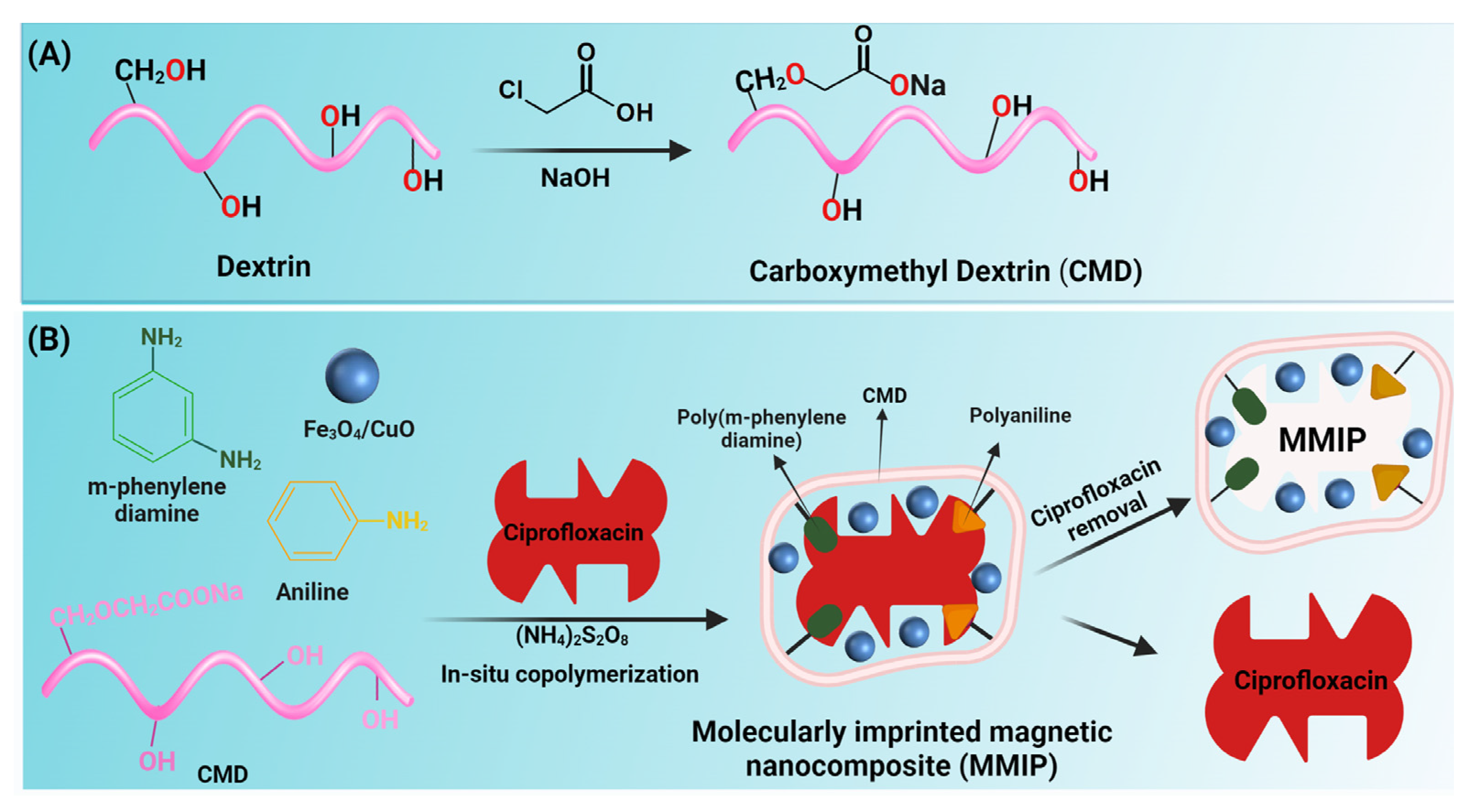


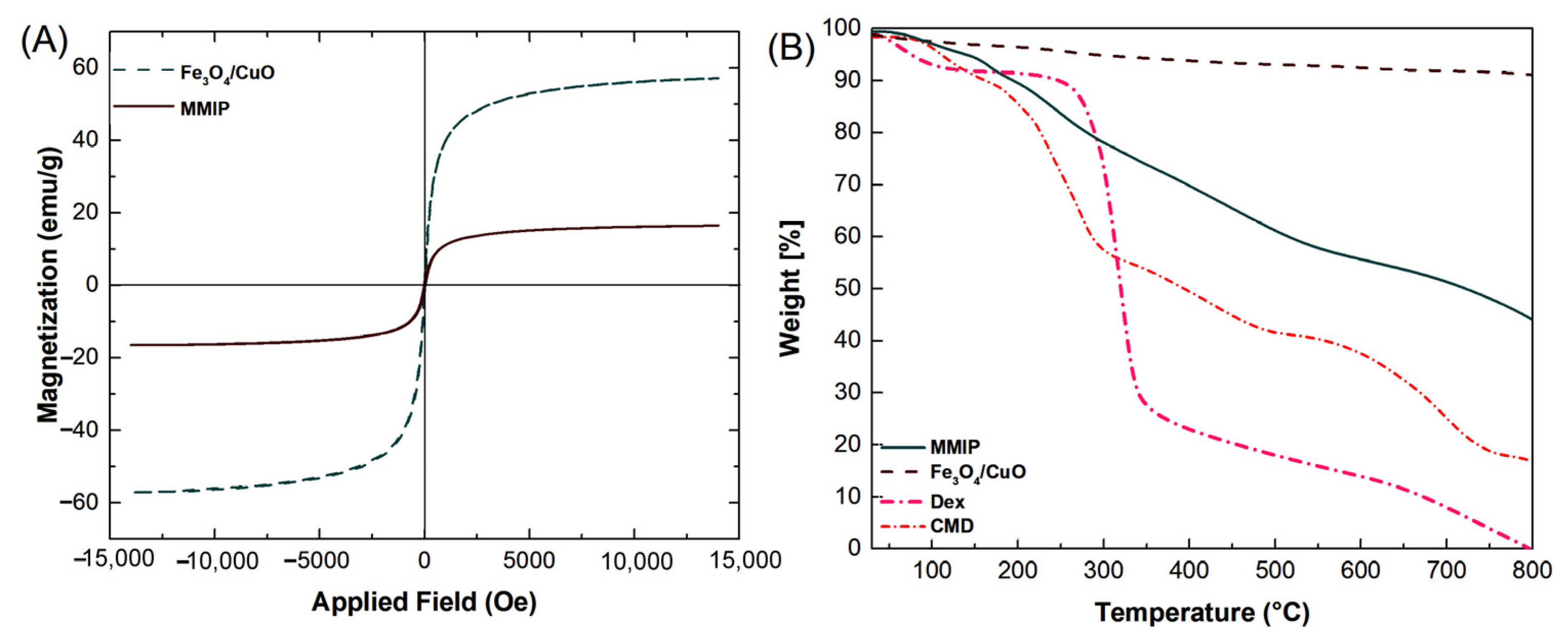

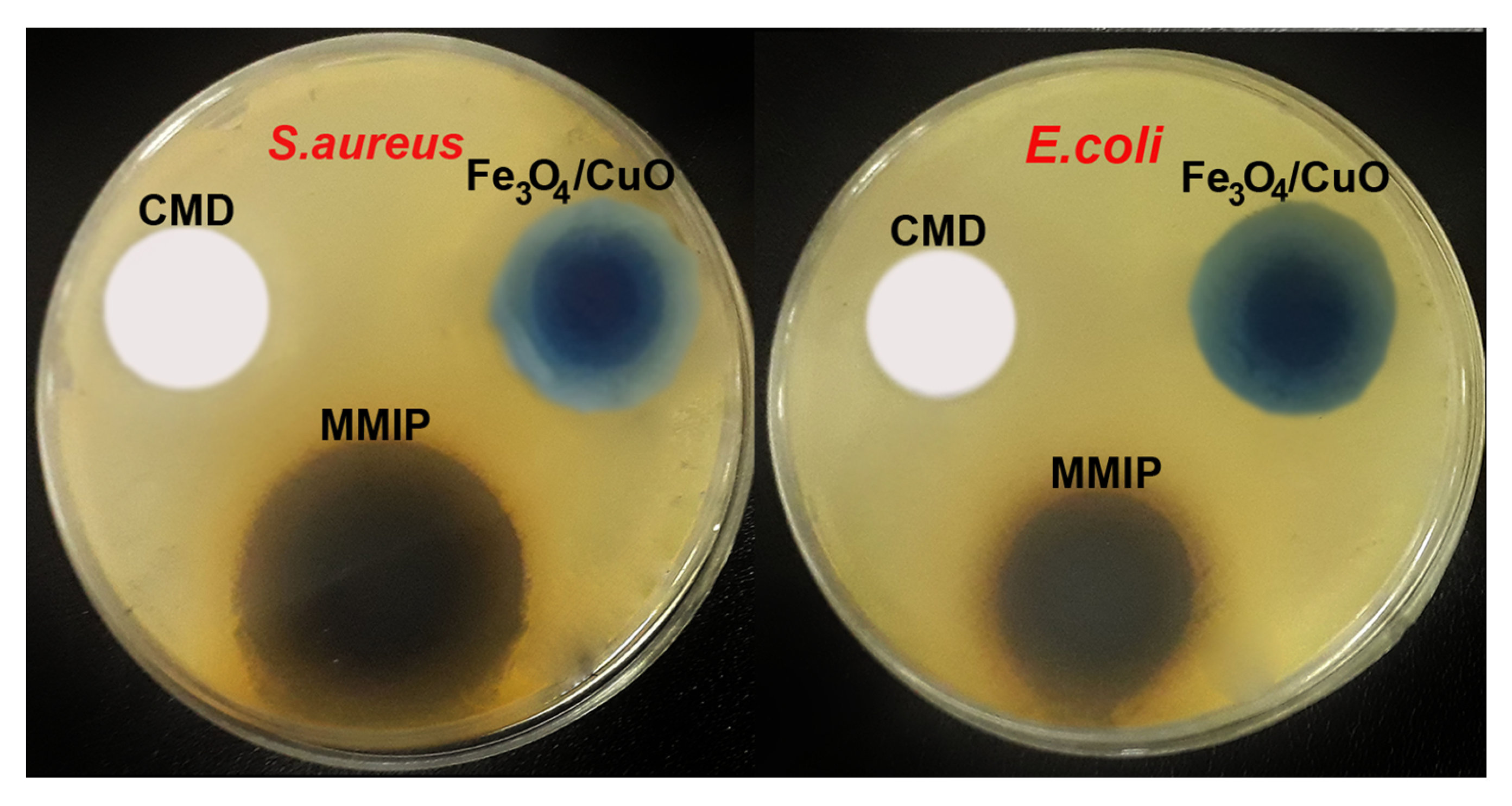
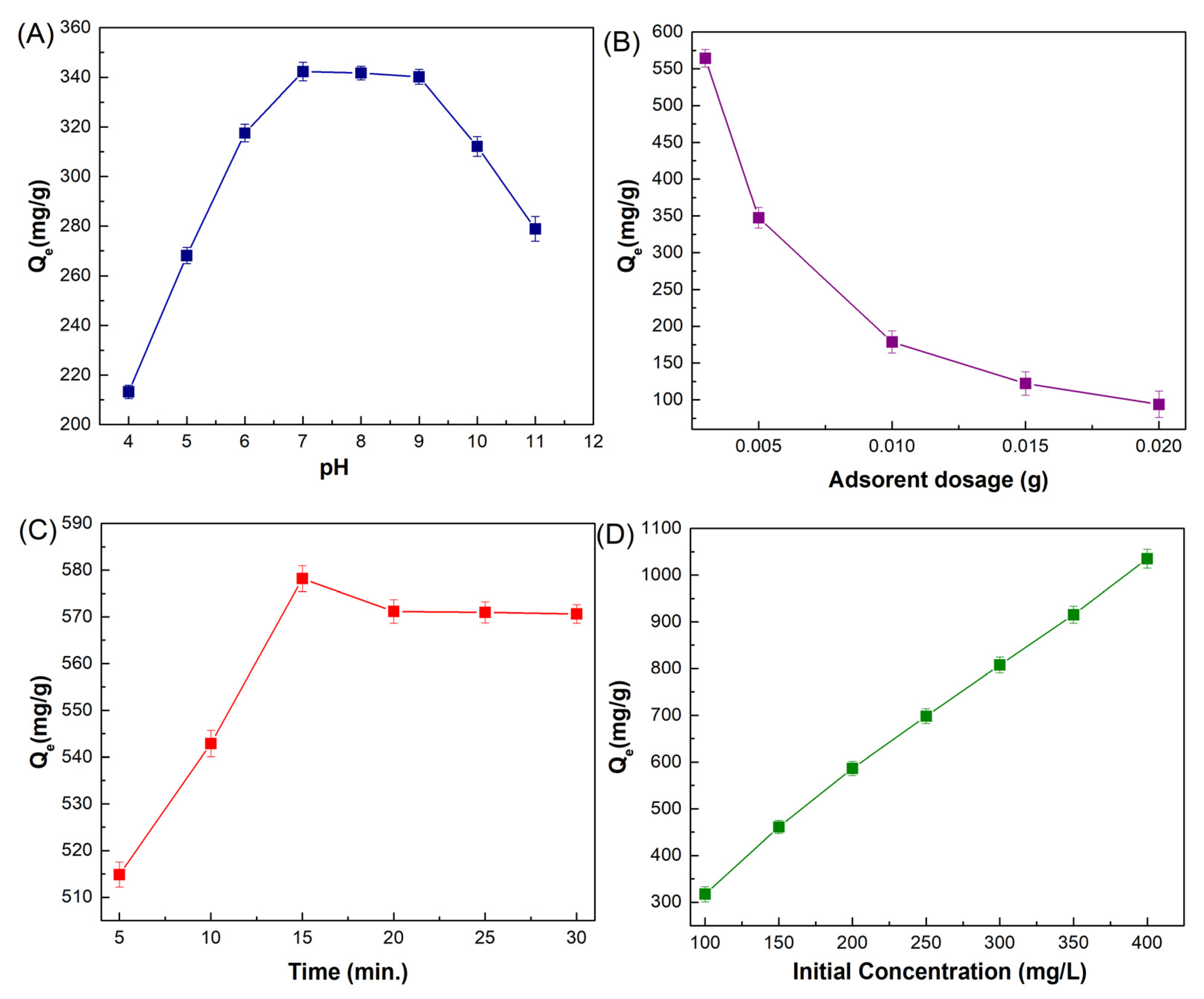
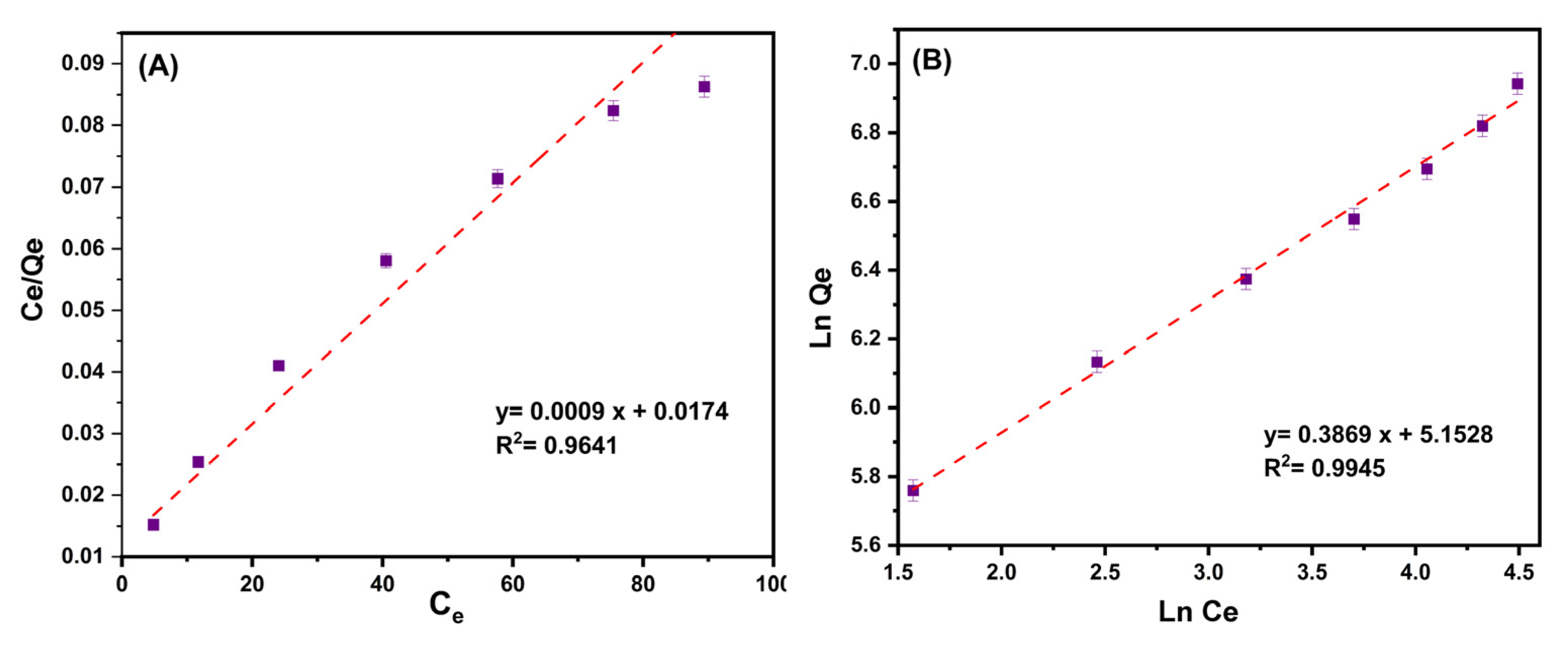
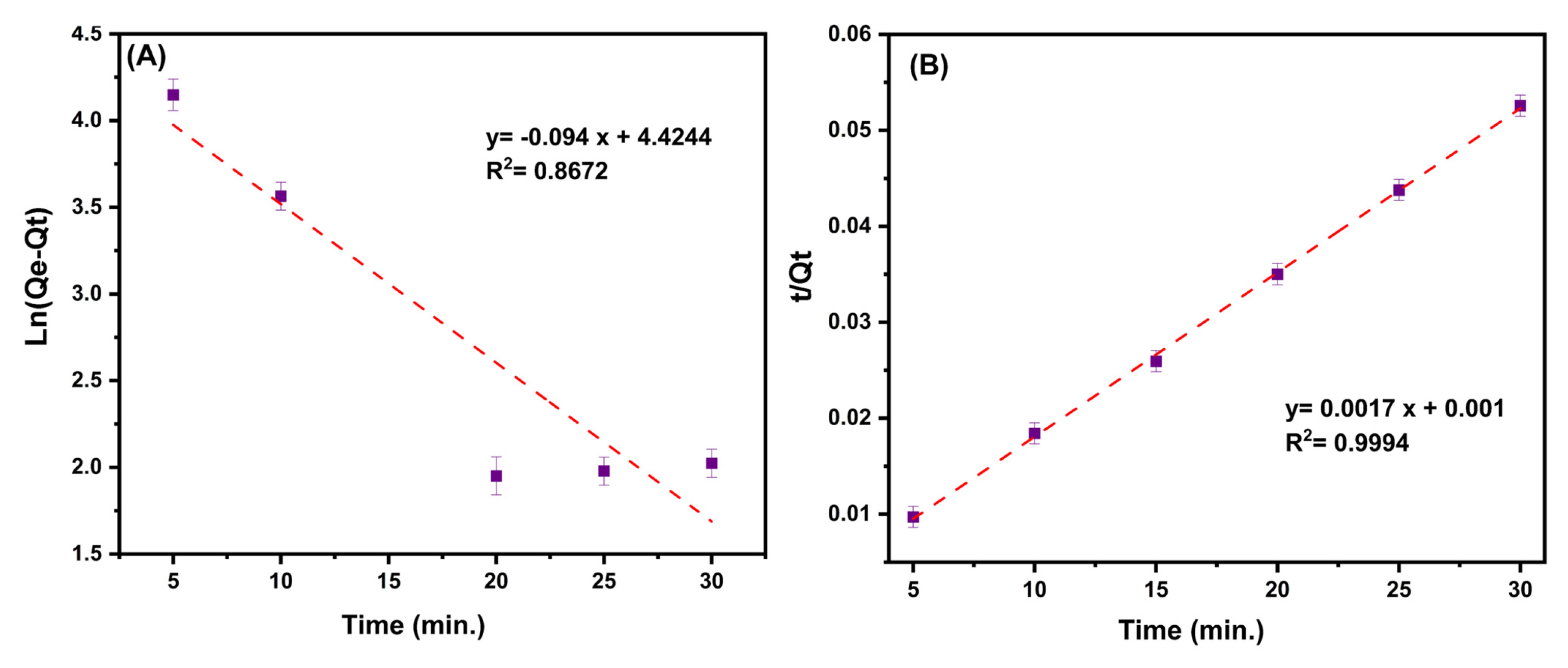

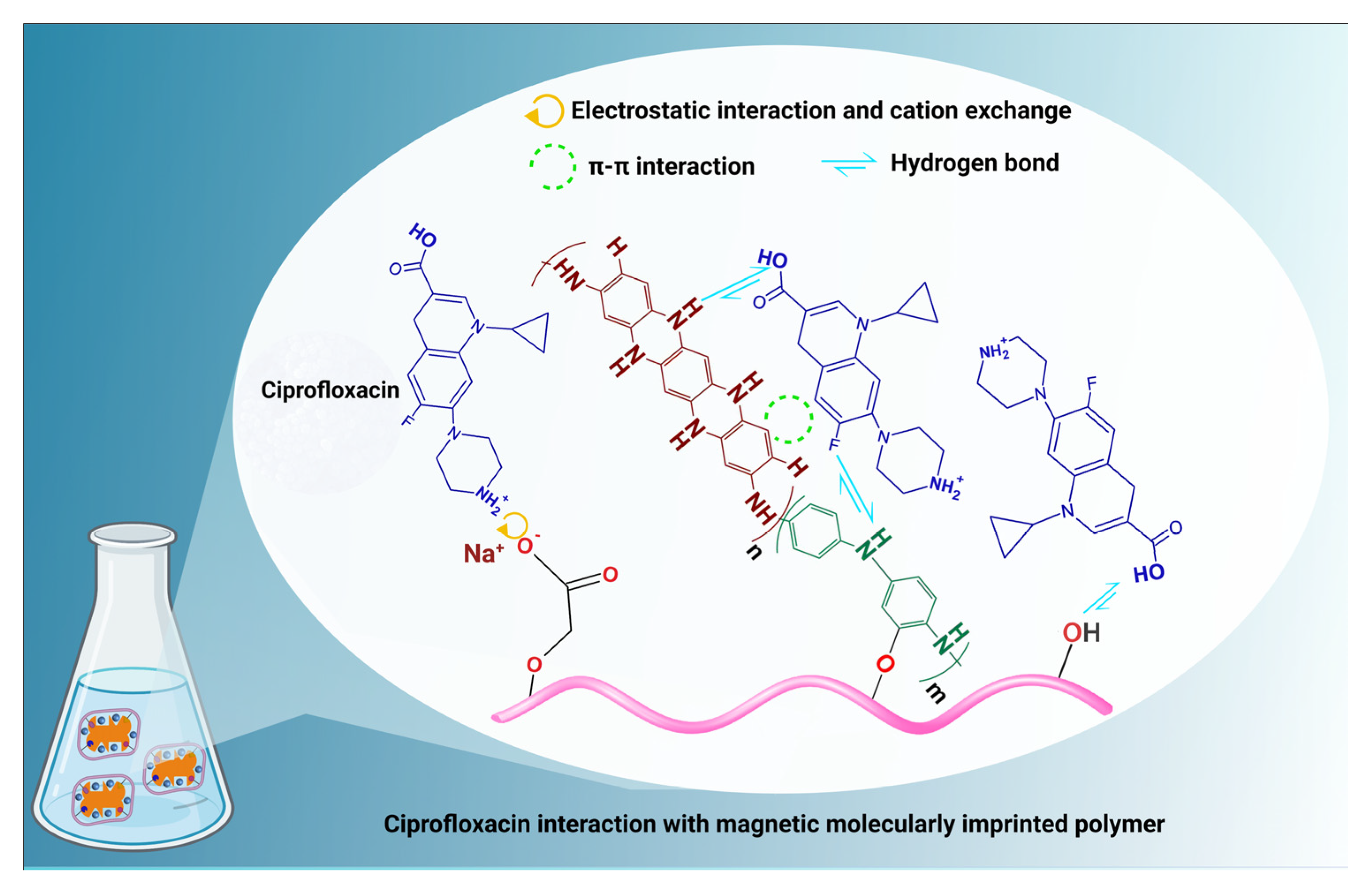
| pH | Zeta Potential (mV) |
|---|---|
| 6 | −10.45 |
| 7 | −12.72 |
| 8 | −14.68 |
| Sample | E. coli (mm) | S. aureus (mm) |
|---|---|---|
| CMD | NE | NE |
| Fe3O4/CuO | 18 ± 0.9 | 21 ± 0.5 |
| MMIP | 16 ± 1.1 | 22 ± 0.8 |
| Gentamicin (10 μg/disk) | 20.3 ± 1.1 | 24.3 ± 1.5 |
| Chloramphenicol (30 μg/disk) | 21.7 ± 1.5 | 23.7 ± 0.6 |
| Adsorbents | Qmax (mg/g) | pH | Tem. (°C) | Method of Determination | Ref. |
|---|---|---|---|---|---|
| Activated carbon from mangosteen peel | 29.76 | 6 | 25 | Langmuir | [7] |
| Montmorillonite clay | 128.0 | 7 | 25 | Temkin | [6] |
| Acid activated carbon from Prosopis juli-flora | 250 | 4 | 25 | Langmuir | [44] |
| Fe3O4 Nanoparticles | 24.0 | 7 | 25 | Freundlich | [45] |
| Konjac glucomannan/ZIF | 812.4 | 7 | 30 | Langmuir | [47] |
| Magnetic carboxymethyl chitosan | 527.9 | 5 | 25 | Langmuir | [48] |
| Fe3O4-SiO2-Schiff base | 415.3 | 5.0 | - | Freundlich | [49] |
| Al(III)-chelated cryogels of chitosan | 390.0 | 7.5 | 23 | Experiments | [50] |
| Modified alginate/graphene hydrogel | 344.8 | 8.0 | 25 | Langmuir | [51] |
| Sodium alginate/ĸ-carrageenan | 291.6 | 5.1 | 25 | Dubinin-Radushkevic | [52] |
| Magnetic chitosan/graphene oxide | 282.9 | 5 | 25 | Langmuir | [53] |
| MMIP | 1111.1 | 7 | 25 | Langmuir | Present work |
| Model | Parameters | ||
|---|---|---|---|
| Isotherm | Freundlich | KF (L/mg) | 172.915 |
| n | 2.584647 | ||
| R2 | 0.9945 | ||
| Langmuir | Qm (mg/g) | 1111.11 | |
| KL (L/mg) | 0.051724 | ||
| R2 | 0.9641 | ||
| Kinetics | Pseudo-first-order | k1 | 0.094 |
| Qe (mg/g) | 83.46271 | ||
| Qe experimental (mg/g) | 578.2 | ||
| R2 | 0.8672 | ||
| Pseudo-second-order | k2 | 0.00289 | |
| Qe (mg/g) | 588.2353 | ||
| Qe experimental (mg/g) | 578.2 | ||
| R2 | 0.9994 |
Disclaimer/Publisher’s Note: The statements, opinions and data contained in all publications are solely those of the individual author(s) and contributor(s) and not of MDPI and/or the editor(s). MDPI and/or the editor(s) disclaim responsibility for any injury to people or property resulting from any ideas, methods, instructions or products referred to in the content. |
© 2023 by the authors. Licensee MDPI, Basel, Switzerland. This article is an open access article distributed under the terms and conditions of the Creative Commons Attribution (CC BY) license (https://creativecommons.org/licenses/by/4.0/).
Share and Cite
Heidari, G.; Afruzi, F.H.; Zare, E.N. Molecularly Imprinted Magnetic Nanocomposite Based on Carboxymethyl Dextrin for Removal of Ciprofloxacin Antibiotic from Contaminated Water. Nanomaterials 2023, 13, 489. https://doi.org/10.3390/nano13030489
Heidari G, Afruzi FH, Zare EN. Molecularly Imprinted Magnetic Nanocomposite Based on Carboxymethyl Dextrin for Removal of Ciprofloxacin Antibiotic from Contaminated Water. Nanomaterials. 2023; 13(3):489. https://doi.org/10.3390/nano13030489
Chicago/Turabian StyleHeidari, Golnaz, Fereshte Hassanzadeh Afruzi, and Ehsan Nazarzadeh Zare. 2023. "Molecularly Imprinted Magnetic Nanocomposite Based on Carboxymethyl Dextrin for Removal of Ciprofloxacin Antibiotic from Contaminated Water" Nanomaterials 13, no. 3: 489. https://doi.org/10.3390/nano13030489








